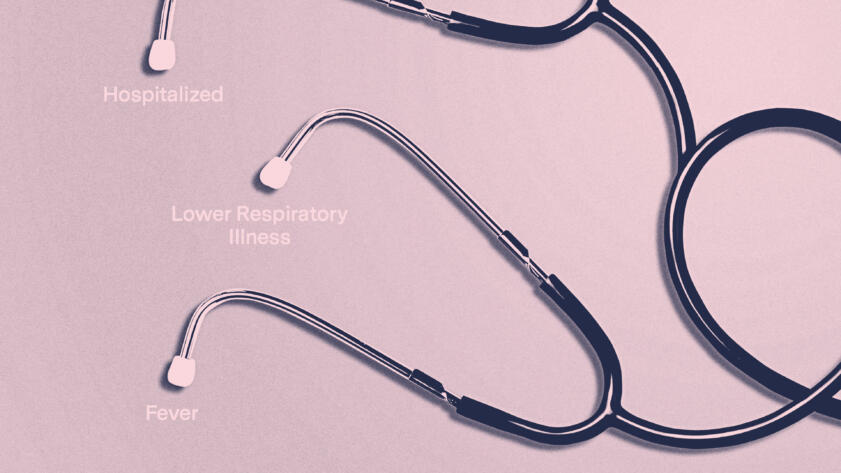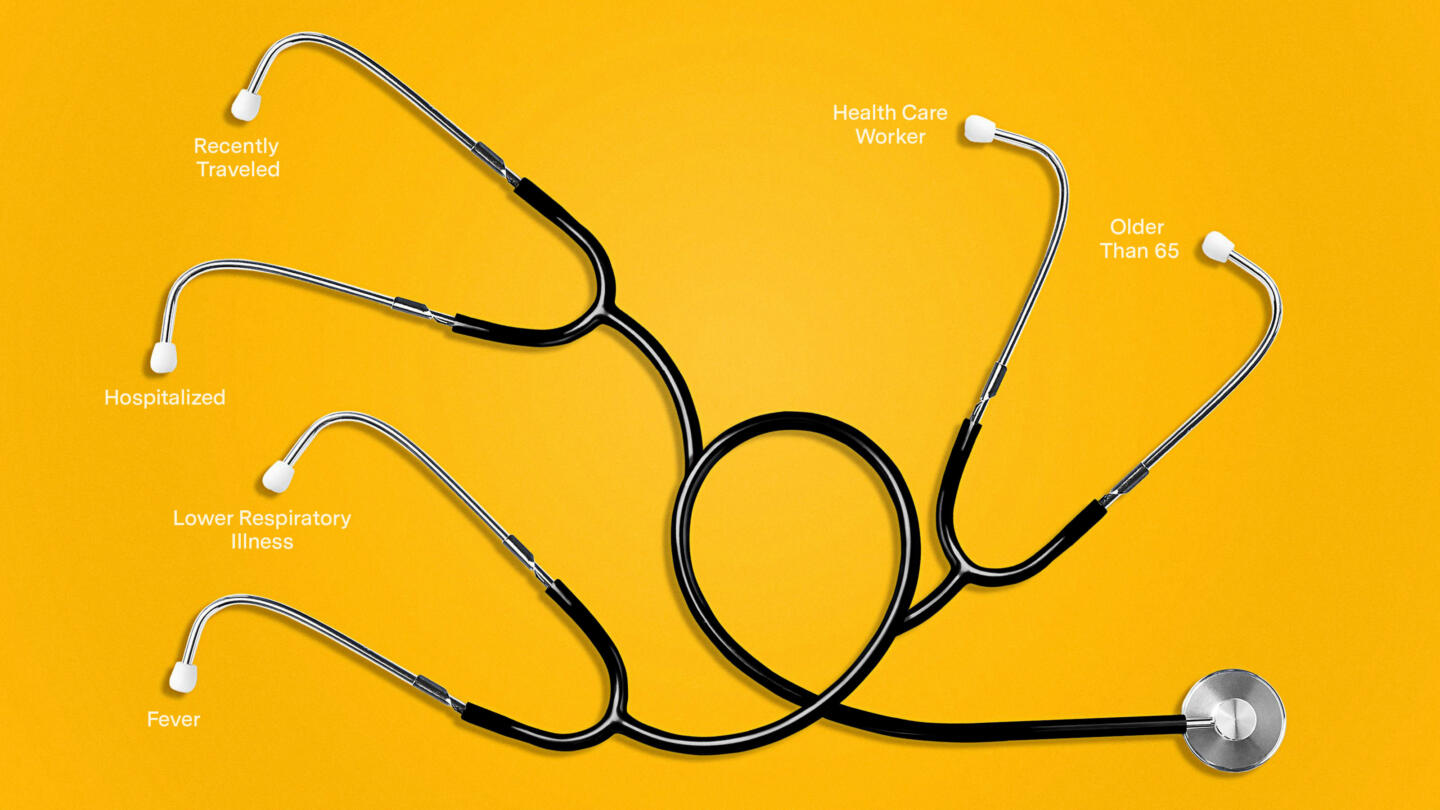Almost all of the adults in Emily Bairos’s household have symptoms of the coronavirus: fever, congestion, some shortness of breath. But Bairos, a 33-year-old teacher on Massachusetts’s North Shore, her husband, and her mother-in-law have spent weeks struggling to get tested.
“Basically we’ve been told to stay at home (which we were already doing, obviously) and go to the ER if we are having serious difficulty breathing,” Bairos said in an email to The Markup.
Doctors working with private labs, including a drive-through testing site Bairos tried, have some discretion in how they conduct tests. It would also have been difficult for Bairos’ family to get testing through a state lab. In Massachusetts, the testing guidelines set by the department of public health for the state laboratory, published on March 13, are strict. The guidelines prioritize health care workers, hospitalized patients, and some people who’ve come into contact with confirmed cases and had contact with “numerous” others. Those guidelines are also shifting: As of April 2, Massachusetts had removed guidance that suggested testing for people who’d come into contact with confirmed cases.
But if the family lived in Idaho, Bairos’s husband would likely qualify for a government lab test under last month’s state guidance, according to a March 11 memo obtained by The Markup through a public records request. Her husband recently learned that a work colleague tested positive, which is one of the criteria prioritized for testing in that state.
And if they lived in Nevada, Bairos’s mother-in-law might have been eligible for testing because she has a history of respiratory issues. According to records, as of March 24, the state was recommending those with underlying medical problems be tested if a health care provider suggests it.
These disparities show how widely the states differ in their responses to the health crisis. Last month, The Markup sent public records requests seeking the testing algorithms published by health officials in all 50 states, New York City, and Washington, D.C., to try to understand the differences among states—the way one health department’s testing procedures may vary from a neighbor’s, and the reasons why.
So far, we’ve received responses from 16 states (plus information on an additional four jurisdictions whose guidance was already public), as well as denials or emergency postponements from four states and D.C. We’re formally appealing decisions in two states and refiling in one.

Show Your WorkCoronavirus
How We Analyzed States’ Coronavirus Testing Plans
We’ve seen some pushback from states. In Hawaii, for example, the governor has suspended the law covering public records requests while the pandemic is ongoing, effectively shutting down the system. A response to our request to the state has been “postponed indefinitely.” Washington, D.C., has also postponed a response during the emergency. Several other states have enacted similar measures.
The situation around the country is fluid, and states have been regularly updating their testing guidance, meaning it’s only possible to get a snapshot of the testing procedures at a particular time. There are also different protocols for state labs and commercial testing, the latter of which have discretion to make their own procedures. Anecdotally, some of the wealthy and famous have also had an easier time reaching the front of the line.
Bairos has observed this ever-evolving landscape firsthand. After first being rejected, she was eventually able to get a drive-through testing appointment from a private care provider, but she isn’t sure what criteria changed. “It’s bewildering,” she said.
Based on the state guidelines we have obtained, here are five theoretical cases and whether the person would be tested in different states:
1. You’re a Health Care Worker
Say you work in a Wisconsin hospital, on the front lines of the pandemic. One day, you find out you’re running a fever. You aren’t ready to be hospitalized yourself—in fact, apart from the fever, you aren’t exhibiting any other COVID-19 symptoms.
According to a March 17 health department memo from the state, you wouldn’t qualify for state lab testing, which requires health care workers to have both a fever and lower respiratory symptoms. The memo mentions health care workers with mild upper respiratory symptoms like sore throat as well, but as of that date, testing was not prioritized for those patients.
That guidance stands in contrast to a March 13 Massachusetts health department memo, which makes health care workers the highest priority for testing. That’s the case even if the workers have only a fever or respiratory symptoms, and even mild symptoms like sore throat should be evaluated for testing, according to the memo.
2. You’re Homeless
Louisiana explicitly prioritizes the testing of suspected COVID-19 cases for those who are homeless, according to a March 19 health department alert from the state. At that time, the state also allowed testing at its state lab for health care workers and those in group settings such as prisons or long-term care facilities.
In other states, it’s less clear how to prioritize homeless patients. Some, like Illinois in one “interim” guidance memo, mention homeless shelters as one of several potential “congregate settings” that should be prioritized for testing.
Many other states’ guidelines don’t specifically mention shelters or homeless people at all, instead pointing only to other congregate settings. Utah’s guidance as of March 12, for example, points specifically to nursing homes.
3. You’re Sick—But Not Sick Enough for the Hospital
If you’re sick and in the hospital, your chances of getting a test are high. But if you’re sick, just not so sick that you’ll be hospitalized, that could change the equation.
New York City, the epicenter of the crisis in the United States, has become grimly exceptional in how it prioritizes testing. In a March 20 guidance update, the city health department directed health care workers to “immediately stop testing non-hospitalized patients for COVID-19” unless it would change their treatment plan.
Other states have various levels of limitations on testing for symptomatic people who are not hospitalized. In Wisconsin, for example, a March 17 guidance prioritizes state testing of health care workers with coronavirus symptoms even if the workers aren’t hospitalized.
And in Missouri, as of March 22, nonhospitalized but symptomatic patients can be tested if they reside in a senior living facility, have certain chronic medical conditions, are immunocompromised, or have come into contact in the last 14 days with a confirmed COVID-19 patient or a suspected COVID-19 patient awaiting test results.
4. You’re 65 Years Old with a Fever
Age has been a key risk factor for prioritizing states’ testing, as older Americans have been hardest hit by the virus. But where states set the bar varies. In Utah, for example, if you’re an otherwise healthy 65-year-old with a fever, you’d meet the criteria for testing as of March 12, according to an alert from the state.
But the situation might be different in Wisconsin, where the state has placed some older Americans—which it defined as those above 50—as lower priority for testing, below hospitalized patients and some symptomatic health care workers. As of March 17, the state said it no longer had the capacity to offer testing in a timely manner for lower priority patients, including those with age as a risk factor.
Others have been more vague. Ohio’s March 20 guidance, for example, simply includes being “elderly” as a factor.
5. You’re in Prison
As with homeless shelters, states prioritize various “congregate” settings for testing, and many—but not all—explicitly mention prisons and jails. Illinois mentions correctional facilities as one prioritized setting, and Oregon includes patients being in “jail/prison” as a factor to consider by health care providers, who can use their discretion for commercial testing, according to a March 16 memo.
Nevada specifically prioritizes patients if they’re part of an “illness cluster.” Among those included: schools, health care facilities, and correctional facilities.





